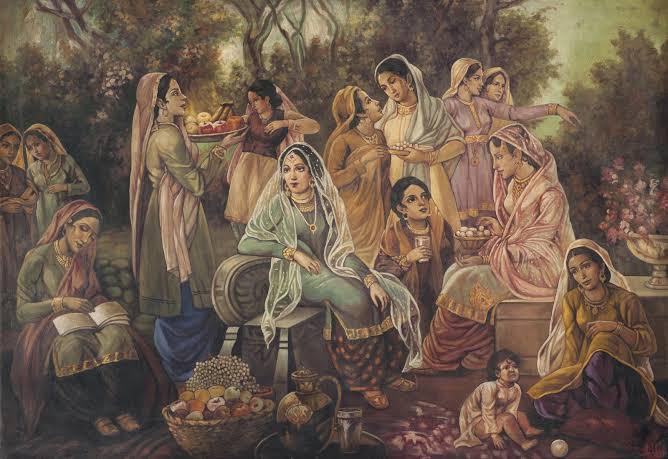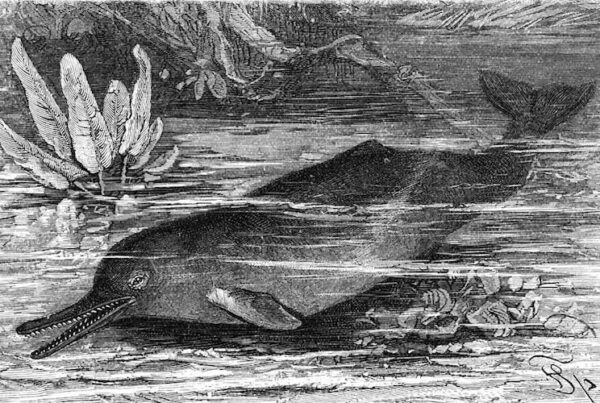If one is to believe Annie Ernaux in her claim that our “primitive memory” deliberately portrays the past as a juxtaposition of light and dark, black and white, then one must also accept that Ustaad Allah Bakhsh’s artwork adds colourful nuance to our contrasting memory of the past. Born to a Rangsaaz (colour maker) (Alam, 2015), it is only fitting that Bakhsh dedicated his life to effectively pigmenting our mythological literature with his majestic hues. Through his brush and canvas Bakhsh recreates the abstract worlds of folklore in a way that replaces them from the realm of imagination to some unknown plane of existence between memory and reality.
To elaborate, while gazing at the many faces in ‘Maha Baharta’ I felt, with unnerving certainty, that I would inevitably lock eyes with my own. It was more than a feeling yet less than knowledge. In my inconsequential 24 years of existence I had perhaps never experienced an ounce of emotion that could compare to the magnitude of sentiment that was portrayed in the image. Yet in that moment I was certain that in the War of Gods I had once been a foot soldier, that I had once witnessed the aftermath of celestial conflict, that I too existed as a forgotten face among the blue or red, permanently pasted to the wall of Alhamra Art Museum. Such is the allure of Bakhsh’s brushstrokes that even the immense irrationality of this belief did not dissuade me from the acceptance of it and I parted from his ‘Maha Baharta’ having left a piece of me behind.
No sooner did I depart the battlefield of Kurukshetra that the resounding cries of Soni tore through the emptiness of the museum and propelled me towards Bakhsh’s ‘Soni Mahiwaal’. Despite knowing the ending of the story, Bakhsh’s lifeless Soni sent shockwaves through what was left of me. I realised that like most brilliant artists Bakhsh invites his viewers on a journey through time and space. But unlike those others, Bakhsh, with ‘Soni Mahiwaal’ takes a detour though memory and redirects us to the site of the wound. The voyage is tumultuous as we find that although it was inflicted centuries ago the wound is still open and gushing with blood. That is to say, pain evades time and ‘Soni Mahiwaal’ is the remembrance of this fact. I stared at his work of art until all I could see was the ache; Soni’s body, surrounded by indecipherable pink objects, became indistinguishable from the water and Mahiwaal’s sorrow became replaced with passivity.
I was suddenly overcome by a sense of kinship with all the generations of women before me who had, in one way or another, relived the same fate as Soni. An open wound can only find new ways to cause pain. An unnerving yet familiar sense of certainty crept into my throat. If I were to run out of the Alhamra Art Museum and dive into the Chenab I would find Soni’s grave extensively decorated with the dying dreams, silenced thoughts and unspoken words of all the women before me who had lost in love. Was this memory or knowledge? Or just a condition of my existence that Ustaad Allah Bakhsh was trying to inform me of? Now all the pink paraphernalia surrounding Soni’s floating body in Alhamra irrevocably resembled the laurels of pain carried and left by women because of the absence of healing. And I was certain that Bakhsh had painted these abstract reflections with this very intention.
As I stood in the museum reorienting myself, attempting to discern real from memory, I thought of what Caleb Azumah Nelson said about how “everything comes from something else. Which is to say, out of your solid ache comes a gentle joy”. I sought comfort in his words. Perhaps the lives lost in ‘Maha Baharta’ and the love lost in ‘Soni Mahiwal’ and Bakhsh’s surrealist depictions of each of these tragedies is an ode to memory; a lesson in the frailty of it. And there is some joy to be derived from the fact that this vigil of remembrance exists in the centre of our city. If one listens closely, amidst the wailing of car horns and the sobs of sirens you can still hear the cries of war. Ustaad Allah Bakhsh spilt oil on canvas and created a looking glass stained with folklore in pastel. While you look through the glass, it looks into you. So as I left Alhamra Art Museum I was unsure whether I was carrying the message of his paintings or if the message was moving me. Either way I left with the resounding belief that my face stayed there, indefinitely staring at the sparsely decorated wall opposite the ‘Maha baharta’ and that I would one day return to Soni’s grave to garnish it with my lost love. I had peered through Bakhsh’s looking glass and seen what my memory had concealed from me; the colourful immortality of our folklore. The war does not end, the wound will never heal.
Written By Misha Anwar
Refernces
Alam, N. (2015) The ustad of ustaads, DAWN.COM. Available at: https://www.dawn.com/news/1195894 (Accessed: February 10, 2023).
Ernaux, A. (2000) Happening. London: Fitzcarraldo Editions. Nelson, C.A. (2022) Open water. London: Penguin Books.




